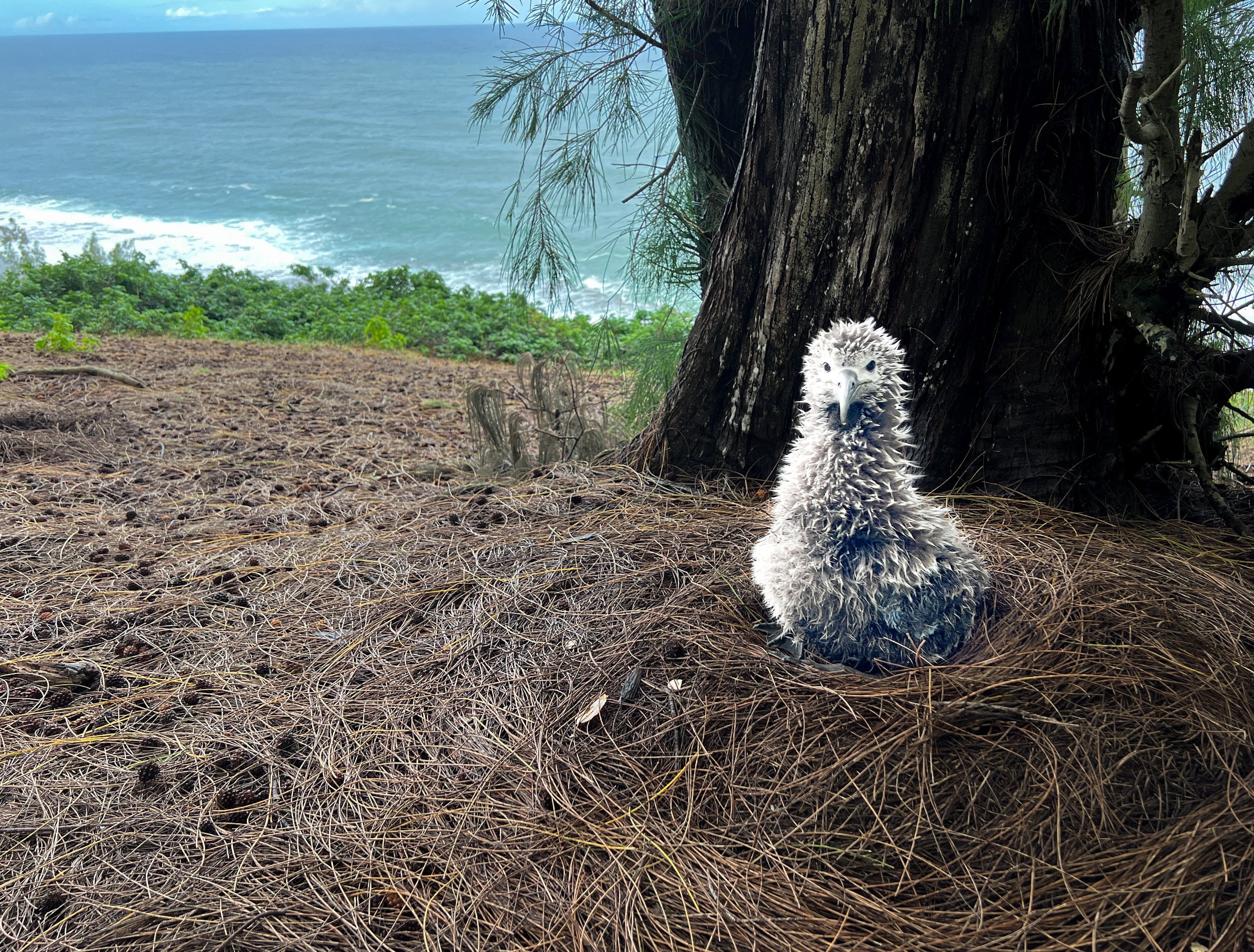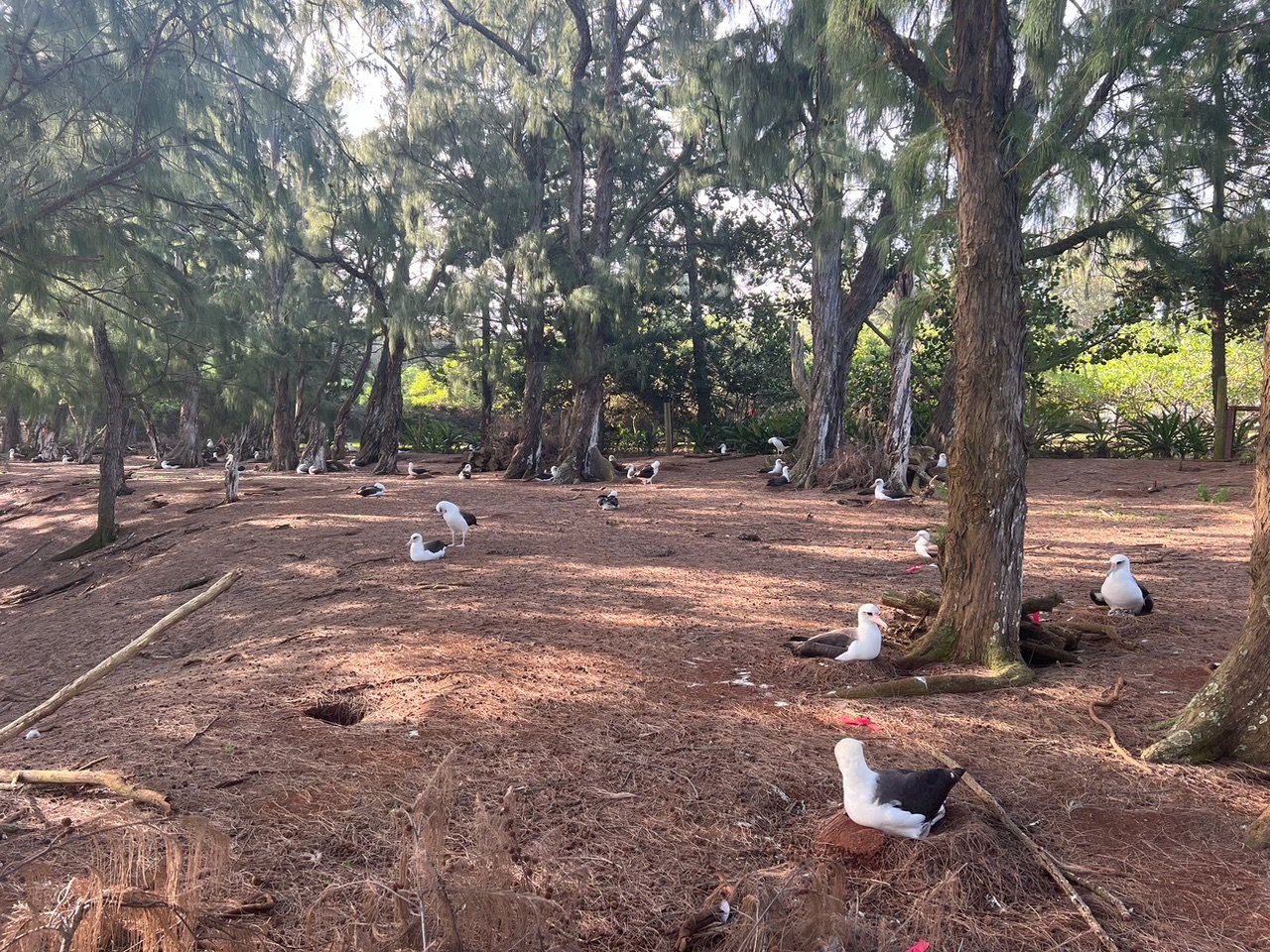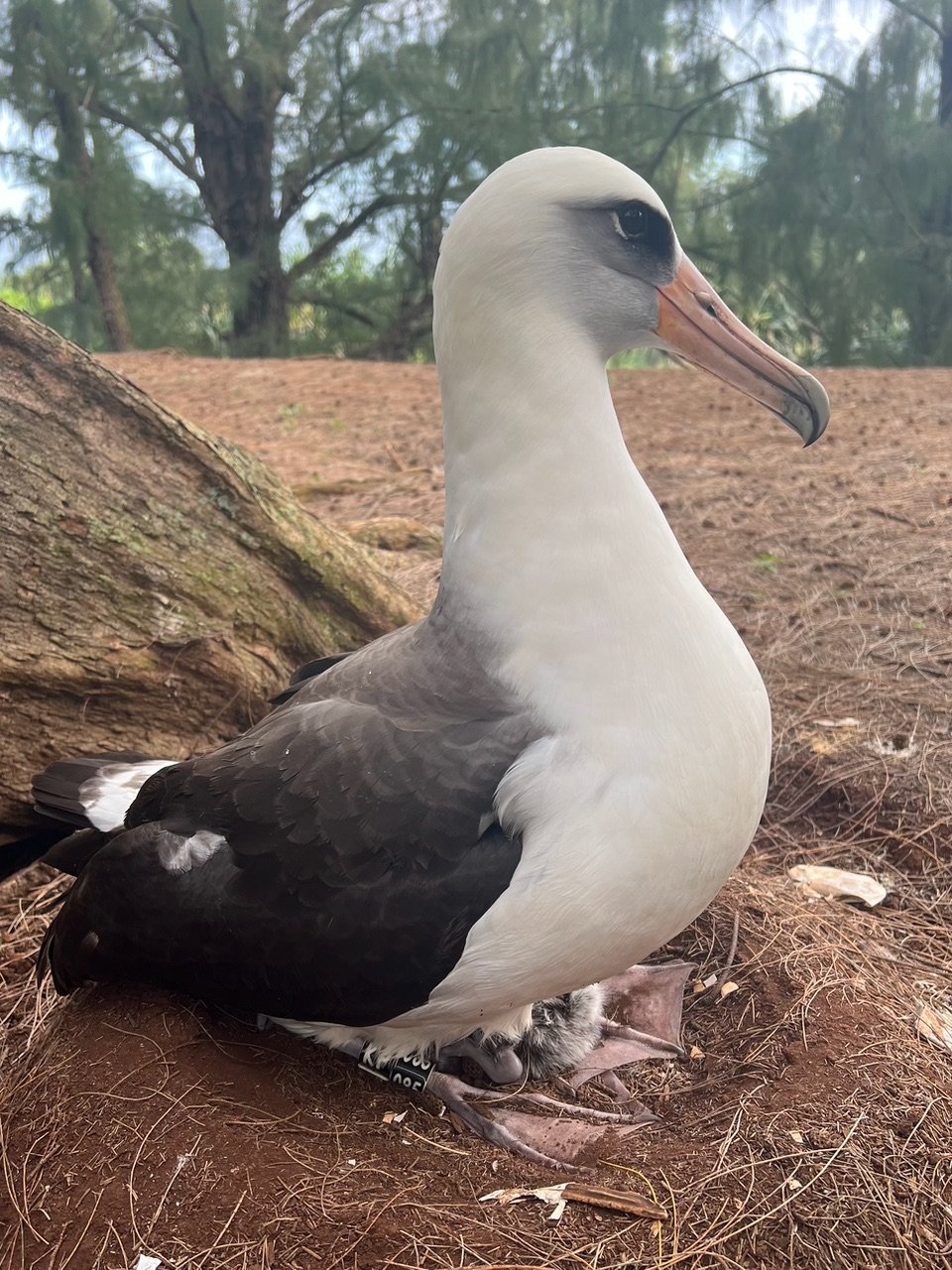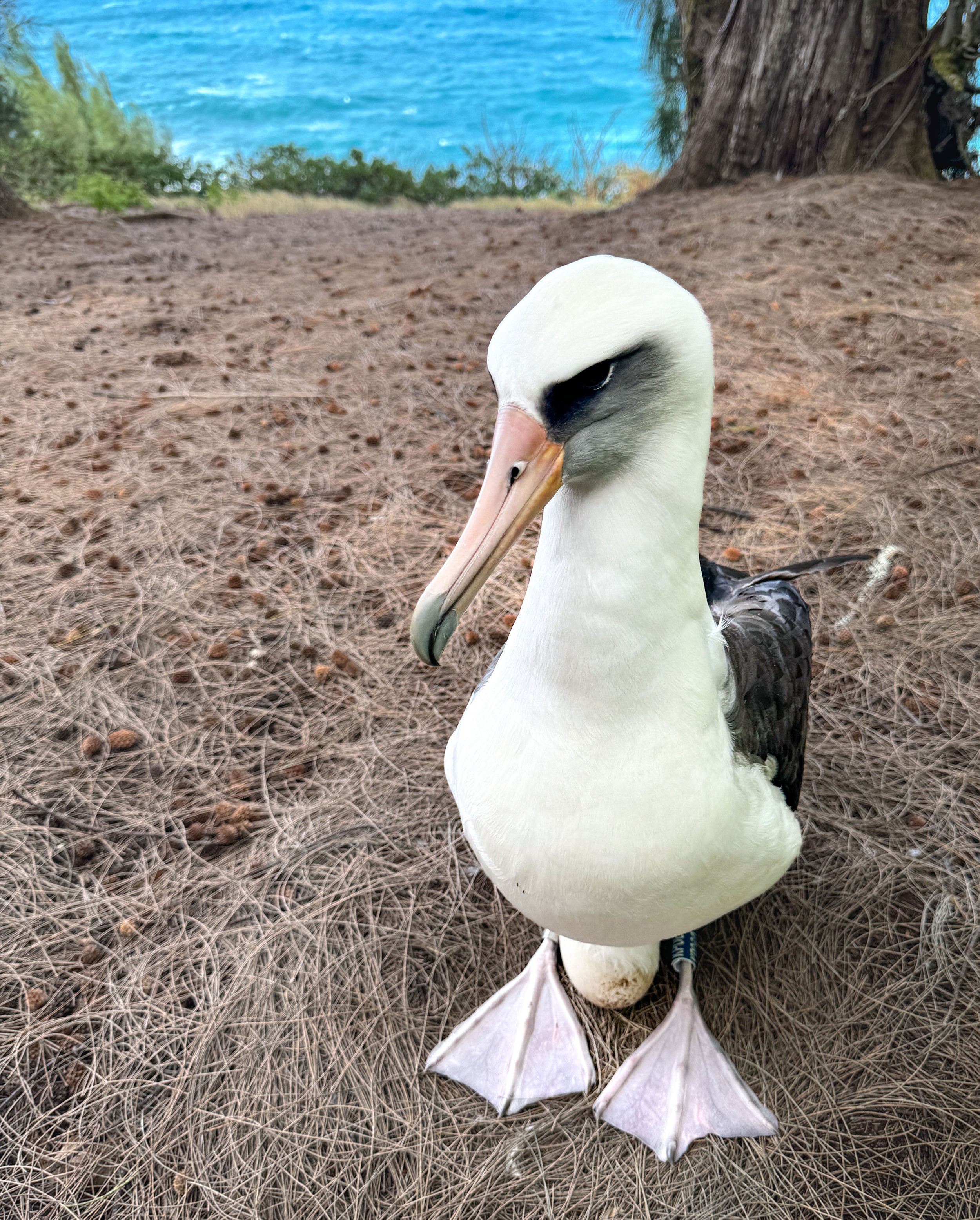OMG It's the OMK: The Search for the Oldest Mōlī on Kauaʻi
By Safina Center Conservationist-in-Residence Hob Osterlund
Eddie, the daughter of one of the oldest mōlī on Kauaʻi, one month old, 2023. ©Hob Osterlund
Perhaps you’ve read obituaries honoring the world’s oldest birds: about Ingo the Flamingo, who recently died in the Berlin Zoo at the (estimated) age of 75; about Cookie, a Major Mitchell’s cockatoo who died in 2016 in a zoo near Chicago at the age of 83; or about Poncho, a green-winged macaw, who was officially the world’s oldest living parrot before he died in Shrewsbury in the U.K. at the ripe old age of 97.
But how much do we know about our wild senior citizens, the ones who are not in captivity and still thriving? The birds who find their own food, evade predators and adapt to human-made alterations in climate and habitat?
An albatross has long been known as the leading contender.
Wisdom, a Laysan albatross (“mōlī” in Hawaiian) has nested for decades at Kuaihelani (Midway Atoll National Wildlife Refuge) in the northwestern Hawaiian Islands. She is estimated to be 72. By my math, that’s conservative—I think she’s likely at least 77.
When a girl makes it that far, she deserves credit for every single year.
Here on the “main” Hawaiian Islands, we have an unusual and wonderful opportunity to seek out the older wild birds among us, or at least the oldest albatross. Why? Because most of the mōlī who grow up here are banded as chicks, so we know their hatch year. Many other mōlī are banded as adults, so their age can only be estimated as an “at least” number.
Mōlī Hill at Kīlauea Point National Wildlife Refuge (KPNWR) ©KPNWR.
Thanks to records maintained by the U.S. Fish and Wildlife Service, we have access to banding data since 1979, back when a mōlī chick fledged from Kauaʻi for the first time in perhaps a thousand years. But those vital numbers are only one bookend of what we need. They tell us when the birds were banded, and may even occasionally tell us if the birds were later resighted. Ultimately, however, the other bookend requires human boots on the ground to tell us which of those birds are still walking/flying/courting/mating/nesting among us.
There are essentially no albatross on Maui, Lanaʻi, Hawai’i Island or Moloka’i, largely due to introduced predators, especially mongoose, wild pigs and feral cats. That leaves Kaua’i and O’ahu. O’ahu does support a population of mōlī, primarily in areas with predator-resistant fences. Lindsay Young, PhD, Executive Director of Pacific Rim Conservation, says their oldest known bird was banded as an adult 37 years ago. So what about Kaua’i?
Oldest (known) Mōlī on Kauaʻi (Overall Winner)
So far the winner is KP437, who was banded as an adult in January, 1987. Likely to be female, she was officially listed as “at least” two years old when banded. That makes her a minimum of 37 years old. Since mōlī chicks typically donʻt return to terra firma until theyʻre 4-5 years old, sheʻs likely 40 or older. Not a lot is known about her, since she tends to nest in quite an isolated area. In 2023 she had a failed nest at Kīlauea Point National Wildlife Refuge, perhaps as a result of pig predation. In 2022 she had a female partner (KP067, herself a contender, banded as an adult in 1990) but their egg was abandoned for unknown reasons. In 2021 the pair also nested, but their egg failed to hatch. KP437 has been seen as a “walker” this year, meaning she’s not nesting. Since the predator-resistent fence at KPNWR is now complete, we hope our reigning OMK can safely nest in 2025.
Oldest (known) Mōlī on Kauaʻi (Active Nester Division)
A female albatross KP085 hatched, was banded and fledged in 1987, so we know for sure she’s 37 years old. Of note: so far KP085 is the only known survivor of the 1979-1987 cohort, which consisted of a total of about 25 chicks. Her mate is K921, likely a much younger bird, banded as an adult in 2011. In 2023 and 2022, KP085 was seen and categorized as a walker. Records prior to that are spotty, so we don’t know if/when she nested previously. Since mōlī typically start nesting at age 9-10, It’s highly likely she has indeed nested multiple times and out-survived other mates.
KP085 with newly-hatched chick, 2024. ©Kīlauea Point National Wildlife Refuge (KPNWR)
Oldest (known) Mōlī on Kauaʻi (Social Media Division)
A male mōlī KP060 (blue), is now 30 years old. For several years he has nested with KP311, (likely) a younger woman, banded as an adult in 2003. Last year their egg was the first one of the season laid in a colony on private land. As fate would have it, that egg hatched on the same day as the Eddie Aikau Big Wave Invitational. “The Eddie” is a uncommon and momentous event in Hawaiʻi. Eddie was a legendary lifeguard and surfer who died in 1978 when he was only 31 years old.
So of course that freshly-hatched chick got named Eddie, and the parents got named after the human Eddieʻs parents, Sol and Henrietta. Eddie the mōlī thrived, and was quite a popular social media presence. When Eddie was a few months old and DNA tested, we discovered she was a she. Her name remained unchanged. Big and strong, she was the first to fledge from her colony.
Stay tuned. Now that we have many of the documents we need and quite a few pairs of eyes in various colonies on the birds, new records will fall and rise. You never know. In the meantime, long may many magnificent mōlī return to a safe home on Kauaʻi.
Eddie gets air as she practices flight, 2023. ©Hob Osterlund






